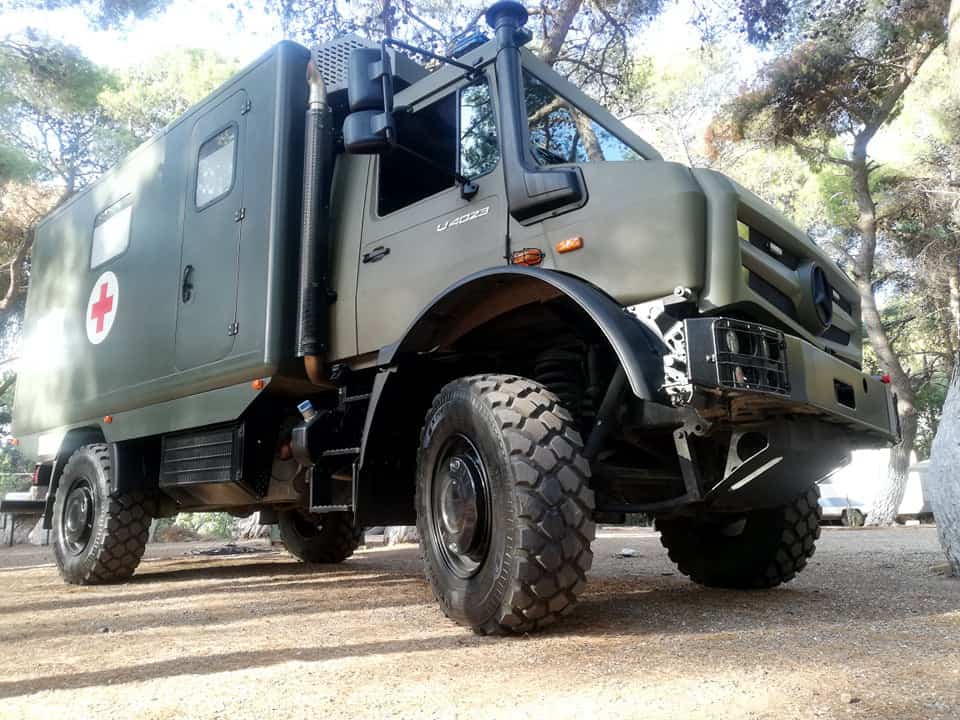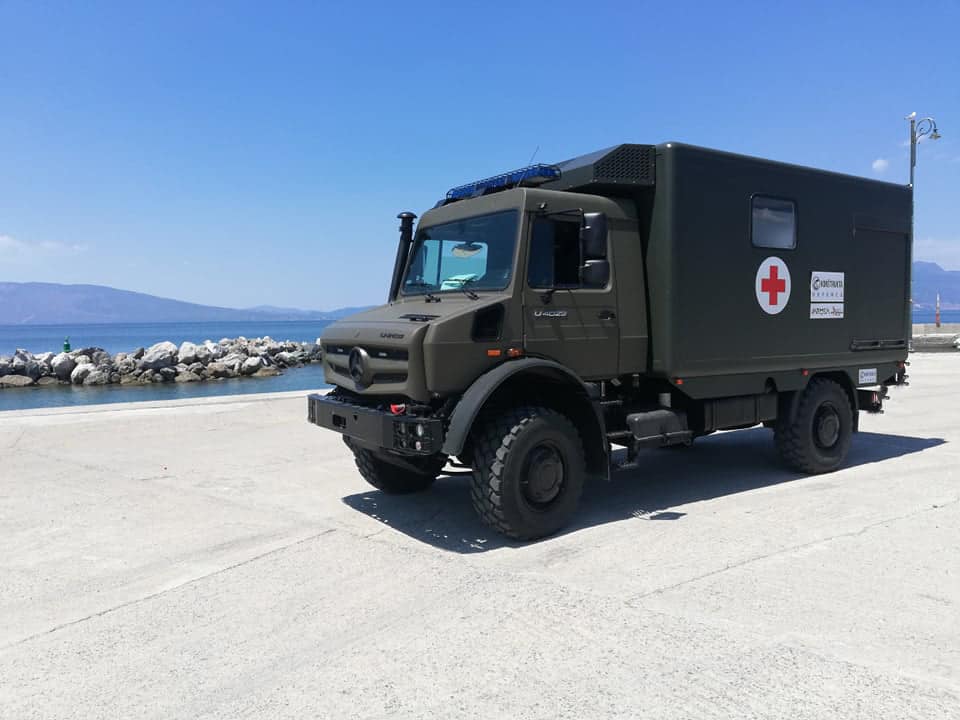The UNIKAR.01 Sanitary Vehicle Project has been realized on a cooperation basis between companies of KONŠTRUKTA – Defence, a.s. Dubnica nad Váhom, ARMEA, s.r.o. Michalovce and AGREGATY PEX-POOL PLUS, Poland.
The Unikar.01 is a sanitary vehicle based on a Mercedes UNIMOG 4023 chassis with high off-road capacity and 4×4 drive.
Thanks to the use of modern technologies, the ambulance is equipped with proven systems established within NATO Armies.
The vehicle is furnished with modern medical equipment.
UNIKAR.01 is designed to transport up to 9 people in the following configurations:
Cabin:
– driver
– 2x Passenger
Ambulance:
-doctor
– 2x lying patient
– 3x sitting patient
Engine:
Diesel, air-filled, water-cooled
Engine power 170kW / 231HP
The engine is run on Diesel and F-54 fuel (NATO)
Transmission:
Gearbox with short switching times,
Synchronized, electro-pneumatic controlled EPS mechanical transmission with 8 forward gears and 6 reverse gears.
Mobility parameters:
Maximum vehicle speed 90km / h,
Drive (4×4) – both axles of the vehicle are driven,
Reinforced gantry axles with reducers,
Fully welded frame and encapsulated drive system for long life.
Screw-resistant vehicle frame.
Reduction of terrain ratio to overcome climbs by up to 100%
Wading up to 0.8m, on request up to 1.2m
Transition angle: 41 ° / 39 °
Climatic resistance:
All powertrains, instruments and equipment of the vehicle are capable of year-round operation in areas with an environmental classification according to STANAG 4307 with the climate zone designation A1 “extremely hot and dry”, A2 “hot and dry” (area of southern Europe, south-central Asia, central and East Africa), A3 “transitional-mixed”(non-southern region of Europe) and C1 “transitional-mixed” (central Europe).
Surface protection
KHAKI coating according to STANAG 7094 and AECIP-300, with increased resistance to operational wear. The coating of the protection represents climatic and corrosion resistance, abrasion resistance, resistance to the effects of combat poisons and decontamination agents,
Non-metallic parts of the chassis and superstructure are resistant to microbial decomposition (mold, fungi, rot),
Climatic, corrosion, and chemical resistance for the degree of corrosive aggressiveness of the atmosphere C3 according to ISO 9223,
Protective cavities of steel supporting profiles of the cabin, including interior spaces of doors, conservation of cavities is performed by preservatives.
Cabin equipment:
Driver’s seat, height and length adjustable with locking, adjustable backrest inclination, headrest,
Other seats fitted with head restraints,
AKB disconnector within reach of the conductor,
Seat belts in all seating positions,
Lamp for reading maps at the passenger seat,
Socket in the driver’s compartment for the mounting lamp and other appliances,
Work light located above the rear door,
A place to store the personal weapons for the driver and front passenger,
A place to store the vehicle’s operational and accompanying documentation,
Location for mandatory equipment and optional equipment of the vehicle (snow chains, winch kit, etc.),
Washable sheet metal anti-slip floor with outlets,
Portable fire extinguisher,
Set of connecting jumper cables,
A set of necessary spare parts with tools as recommended by the supplier,
Preparation for the installation of a radio station, navigation device,
Mechanical air conditioning,
Location of information and warning labels.
Dashboard:
Luminance regulation,
Designation of controls, tell-tales, and indicators according to STANAG 4050.
Vehicle electrical system parameters:
The voltage of electrical accessories 12V / 24V,
The capacity of the accumulator batteries and the power of the alternator are sufficiently dimensioned according to the vehicle version,
Possibility of starting from an external 24V source.
Chassis electrical equipment
All vehicle units have interference suppression according to stage II.C (EU72 / 245-95 / 54-1487),
according to MIL-Stan-461A
Lighting:
Headlamps in vehicle body – (side-marker, dipped-beam, and main-beam) headlamp, side direction indicator,
Convoy lights,
Rear group lamps (position, brake, fog, reversing lamp, red reflector),
Rear combined (convoy, cover) lights,
Engine compartment sockets:
NATO socket type 1 according to STANAG 4074 (emergency start),
ZAB socket (emergency start),
Socket for mounting lamp.
Superstructure parameters:
The superstructure is part of a special vehicle for the transport of the sick and wounded ones with the possibility of modular replenishment of equipment (LZP / RLP),
The basis of the vehicle is a two-seat-cab and a special superstructure with the modular system INTRAXX (Integrated Vehicle Component System / FERNO),
New transport system with Mondial stretchers using FERNO Smart-Load technology,
The rear double-leaf door allows both door leaves to be opened by min. 180 ° with locking,
All-aluminium welded superstructure construction,
Superstructure body made of sandwich panels,
Safety openings – also patient and crew evacuation windows located on the sidewalls of the superstructure and in the rear wing and side doors,
Washable material on walls and roof,
Thermal and sound insulation,
Internal communication device between the superstructure and the driver,
Folding and retractable boarding step in the rear and side of the vehicle,
System for inserting stretchers into an ambulance and pulling them out of the ambulance using an internal lift with a load capacity of 500 kg,
Superstructure equipped with modular system Intraxx FERNO / according to use supplemented by devices and equipment corresponding to the type of use / RZP, RLP /.
Internal dimensions of the superstructure:
D3910 mm
W2253 mm
H 1877 mm
Superstructure wiring:
Independent power supply in the form of an additional traction battery (min. 80Ah) with voltage and power switch as well as an external voltage switch for emergency lighting of the body,
Charger socket, 4x 12V socket (two at the rear door, two at the patient’s head).
Superstructure heating and ventilation:
Additional independent heating with air distribution to create physiological conditions for patients and healthcare professionals at outdoor temperatures from -30 ° C to + 60 ° C and outdoor humidity from 0% to 100%.
Activated carbon filtration and ventilation unit with the possibility of using a filter against the effects of biological and chemical substances ensuring the quality and pressure of air for the stay of persons in an enclosed space (microclimate-S), controlled from the superstructure.
Medical equipment:
Intraxx / Integrated Vehicle Component System / FERNO suspension system on the walls of the console superstructure with the possibility of modular addition to the equipment:
Type of infusion material or equipment:
4 liters of solution for infusion
2 pcs accessories for infusions and injections – set
1 infusion system for heating solutions
4 pcs infusion holders
1 piece of pressure infusion equipment
Type of devices for managing life-threatening conditions:
1 piece defibrillator with ZOLL®X Series® heart rate display
Portable defibrillator, ECG diagnostic with interpretation 12
Conductive, 4-divorce ECG, NIBP non-invasive blood pressure, SPO2 – pulse oximetry, ETCO2- capnometry with canofragm (micro stream technology), Masivo rainbow ®,
See-Thru CPR® technology, temporary non-invasive pacing, bizafic defibrillation with rhythm analysis, defibrillation values according to the appropriate type of biphase
Curves, a system of support for proper resuscitation, which measures the depth, frequency and sufficient relaxation of the chest and informs the rescuer in real-time.
Portable Zoll Auto Pulse chest compression device
1 piece of nebulization treatment device EN 13544-1
Dressing and treatment material:
3 pcs of bed linen
2 pcs of blankets, isometric
Protective mask against infections, drape
1 set for the treatment of burns and burns
1 pc emission bowl
1 pocket for return
2 pcs bed bowl
1 urine bottle – plastic duck shape
1 piece container for taking pointed objects
1 pc set for gastric rinsing
5 pcs sterile surgical gloves, pairs EN 455 -1, -2
100pcs non-sterile disposable gloves EN 455 -1, -2
1 pc set for premature birth
1 piece of waste bag
1 bag for clinical waste
3 pcs non-woven tarpaulin for stretchers with tarpaulin tensioner
Rescue and protective material:
Cleaning and disinfecting agents
1pc simple rescue tool, set
1pc scissors seat belt cutter
2 pcs warning triangle/light
1pc reflector
Fire extinguisher EN 3-1
Additional equipment:
Hand-held portable cordless light, hand tools (ax, shovel, 2 wedges), jack with accessories, toolset, set of spare parts.
Patient handling equipment:
1pc Transporter for stretcher F2 EN1865
3 pcs of split stretchers F2 EN 1865,
1 vacuum mattress with pump and carrying bag for stretcher F2 EN 1865
Patient straps on stretchers F2
Attaching the F2 stretcher to the support platform
Leg support for F2 stretchers
Side handles for stretchers
Infusion console for stretcher F2
2 pcs transport chair
1pc Cardiology chair
1 piece carrying cloth or mattress for carrying EN 1865
1 long plate on the spine for fixing the head EN 1865
3 NATO STANAG 2040 stretchers
Immobilisation equipment:
1 piece of towing equipment
1 piece set for immobilization of vacuum plate fractures
1 piece of equipment for immobilizing the cervical spine + collars
1 piece extended equipment for immobilization of the upper part of the spine, KED vest
1 set of fixation set or short splint on the spine
Type of ventilation/breathing set:
1pc stationary oxygen device with min. volume 2000l with Medireq II pressure reducing valve with AGA quick coupling / 2x oxygen 10 kg bottles + distribution /
1pc portable oxygen device ZOLL EMV PLUS 731 series
2 resuscitators with masks and 6 Guedela breathing tubes
1 stationary / portable extractor
Rechargeable battery with wall mounting
Type of diagnostic equipment:
1pc busy pressure gauge with man. From 10-66 cm, with a set of cuffs
Electronic flow pressure monitor with Sure BP system
1 pulse oximeter EN 865
1 stethoscope
1pc thermometer 28 ° C – 42 ° C EN 12470-1, electronic
1 piece of blood sugar measuring device
1pc diagnostic lamp
Communication means:
In-call communication between the driver’s area and the outpatient area.




















